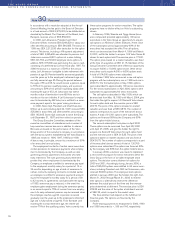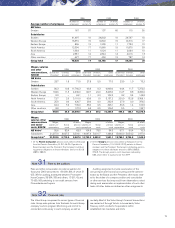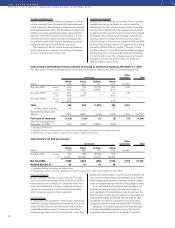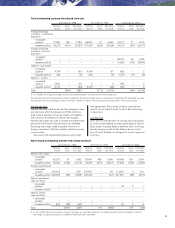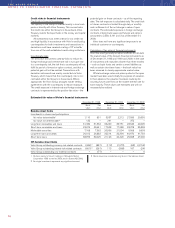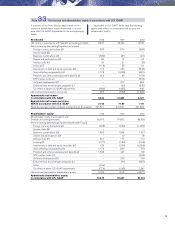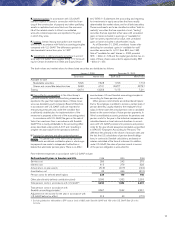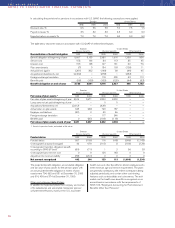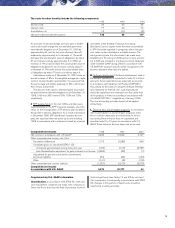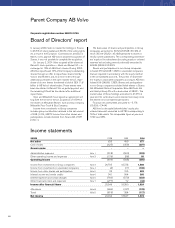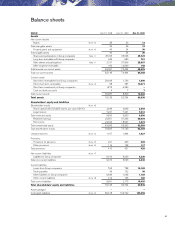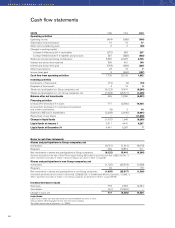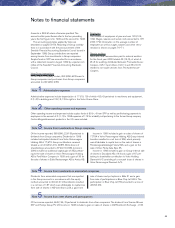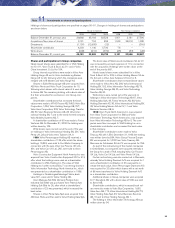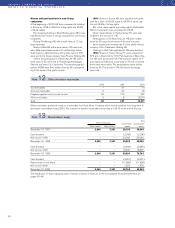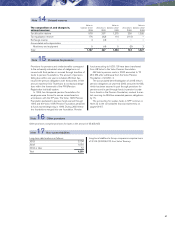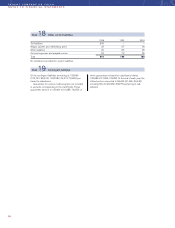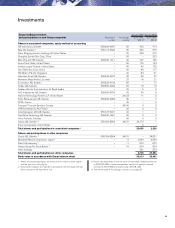Volvo 2000 Annual Report Download - page 81
Download and view the complete annual report
Please find page 81 of the 2000 Volvo annual report below. You can navigate through the pages in the report by either clicking on the pages listed below, or by using the keyword search tool below to find specific information within the annual report.
79
The costs for other benefits include the following components
1998 1999 2000
Service costs 46 35 45
Interest costs 77 60 76
Amortization, net 12 (5) (4)
Net post-retirement benefit expense 135 90 117
Comprehensive income 1998 1999 2000
Net income in accordance with U.S. GAAP 9,432 31,690 3,127
Other comprehensive income, net of tax
Translation differences 1,173 (1,389) 966
Unrealized gains on securities (SFAS 115):
Unrealized gains (losses) arising during the year (186) (419) (3,787)
Less: Reclassification adjustment for gains included in net income (2,655) (43) (1)
Adjustment for pensions and similar commitments
(minimum liability) 452 (54) (132)
Other (141) (8) (119)
Other comprehensive income, subtotal (1,357) (1,913) (3,073)
Comprehensive income
in accordance with U.S. GAAP 8,075 29,777 54
An increase of one percentage point per year in health-
care costs would change the accumulated post-retire-
ment benefit obligation as of December 31, 1999 by
approximately 65, and the net post-retirement benefit
expense by approximately 6. A decrease of 1% would
decrease the accumulated value of obligations by about
57 and reduce costs by approximately 5. In 2000, an
increase of 1% would increase the accumulated value of
obligations by about 81 and increase costs by about 7;
a decrease of 1% would reduce the accumulated value
of obligations by about 70 and cut costs by about 6.
Calculations made as of December 31, 2000 show an
annual increase of 8% in the weighted average per capita
costs of covered health-care benefits; it is assumed that
the percentage will decline gradually to 5% in 2010 and
then remain at that level.
The discount rates used in determining the accumulat-
ed post-retirement benefit obligation as of December 31,
1998, 1999 and 2000 were 6.75%, 7.5% and 7.5%,
respectively.
J. SPP surplus funds. In the mid-1990s and later years
surpluses arose in the SPP insurance company since the
return on the management of ITP pension plan exceeded
the growth in pension obligations. As a result of decisions
in December 1998, SPP distributed, company by com-
pany, the surpluses that had arisen up to and including
1998. In accordance with a statement issued by a special
committee of the Swedish Financial Accounting
Standards Council, surplus funds that were accumulated
in SPP should be reported in companies when their pre-
sent value can be calculated in a reliable manner. The
rules governing how the refund was to be made were
established in the spring of 2000 and an income amount-
ing to 683 was included in the Group’s income statement
under Swedish GAAP during 2000. In accordance with
US GAAP, the surplus funds should be recognised in the
income statement when they are settled.
K. Software development. Software development, used in
the Group’s operations, is conducted in Volvo IT. In Volvo’s
accounts, these expenditures are expensed as incurred.
In accordance with Statement of Position (SOP) 98–1
“Accounting for the Costs of Computer Software Develop-
ed or Obtained for Internal Use” such expenditures
should be capitalized and amortized over the useful lives
of the projects. In Volvo’s accounting in accordance with
U.S. GAAP, SOP 98–1 is applied as of January 1999.
The new accounting principle should not be applied
retroactively.
L. Entrance fees, aircraft engine programs. In connection
with its participation in aircraft engine programs, Volvo
Aero in certain cases pays an entrance fee. In Volvo’s
accounting these entrance fees are capitalized and
amortized over 5 to 10 years. In accordance with U.S.
GAAP, these entrance fees are expensed as incurred.
Supplementary U.S. GAAP information
Classification. In accordance with SFAS 95, “cash and
cash equivalents” comprise only funds with a maturity of
three months or less from the date of purchase. Some of
Volvo’s liquid funds (see Notes 19 and 20) do not meet
this requirement. Consequently, in accordance with SFAS
95, changes in this portion of liquid funds should be
reported as investing activities.



